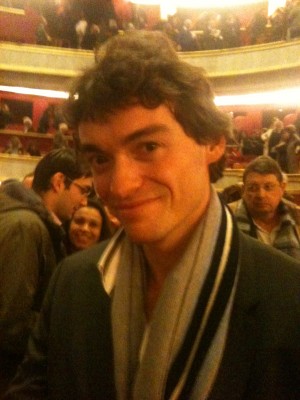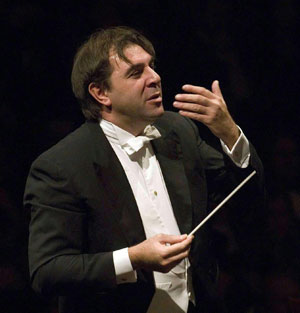BEETHOVEN by Gatti – in Paris
Ludwig van Beethovens 9 symphonies in 5 concerts during 15 days at Théâtre des Champs Élysées in Paris
. 1.-15
. November 2012 with Orchestre National de France, conducted by its music chief Daniele Gatti.
Review and comment by Henning Høholt
PARIS: Even for a socalled “culture expert”, it is importent to go back to the basic repertoire to gain new knowledge, remember, toget new inspiration, pick up forgotten details, the basci, and a new overlook to the matter, and furthermore to feel how todays leading conductor and musicians in the different orchestras are feeling that Beethoven and his Symphonies shall sound to day.
In this actual case the initiative this year from Orchestre National de France and its music chief Daniele Gatti to present all Ludwig van Beethovens 9 Symphonies during 5 concerts in a preiode of 15 days, Thursday 1. – Monday 5.- Thursday 8. -Monday 12, – and finishing with the 9th Symphonie Thursday, the 15th November are welcome.
As we usually get these Symphonies one by one, spread over one or two years, with different orchestras and conductors. This presentation gives us a possibility to listen to them all assembled during a short periode, and with the same orchestra and on conductor, and even with the same Concert Master. In this case the brilliant first violinist Sarah Nemtanu.
The preparation for such a demanding Beethoven presentation including all these new contemporary creations has been enormeouse in planning, rehearsing, preparations, so far it is a good job. And i am looking forward to follow all the 5 concerts.
Therefore, it is strange to me to notice, how few critics, who attended the fist evening with Beethoven by Gatti. Are they afraid to admit that Beethoven and his symphonies are still interesting and that they are in move?
NEW CREATIONs – World premieres.
The other positive side if this seria is that we all the way, every evening get a new creation by a contemporary French composer, who all has got ordered their work by Radio France
. And where they all, in one or another way, has got their inspiration from Beethoven. Furthermore, we dont only get this new work played one time. The new creation is presented after the evenings first Beethoven Symphony, played before the break, then the break, and after the break the same new creation is being repeated
. This gives us the possibility to remember some details, and also to be prepared for the repetition. Which is a very good idea, and generouse to the audience and the composer.
The only evening it is not being played two times is the last evening, where Beethovens Symphony no 9 is programmed, and together with that, before the break, Bruno Mantovanis new creation: Cantate no. 3, dexieme part.
The first Beethoven by Gatti evening started with Symphony no 1 and ended with Symphony no 7.
Between these two we had the new creation.

Fabien Waksman at Théâtre des Champs Élysées, November 1. 2012. Foto: Henning Høholt
PROTONIC GAMES by FABIEN WAKSMAN.
Waksman tells, him self, that he is fascinated by Beethovens capacity to develope and design a great shape from micro-matter. In this matter Waksman are thinking of for exemple the four opening notes in the 5th Symphonie, who is feeding all the first movement of the 5th Symphony with inspiration.
Waksman has found his inspiration to Protonic Games in the collission with very high energy, that seek to achieve particle physicists at CERN in Geneva (CERN is the European Organization for Research Nucleare). As the largest particle accelerator in the world in which proton beams collide at nearly the speed of light these collisions `very high energy generate unstable particles that have existed shortly after the Big Bang.
This double tribute to Beethoven and researchers of the invisible musically based on seven motifs of the Seventh Symphony, but most are unrecognizable “to the naked ear.” “I have indeed varied considerably above the character and the speed of these micro-patterns, real matter particles forming a musical fabric foisinnant and extremely swift.
Particles collide, fall constantly collide, and these explosions are born so other elements themselves continually changing”. Fabien Waksman tells.
It starts with an explosion and ends with an extace. But between these two outher points we find many interesting ideas of how to use a large symphony orchestra in a traditional combination, but with new effects build on the composers mentioned nuclear idea background, which i feel he has succeded in expressing to us. Between the opening part of the explosive nature it gives way to a soft chorale chords, leading to a more contrapuntal musical part, well differentiated. After recalling the beginning. inexorable acceleration combining more patterns in boiling á agreement that ends the solar piece on a note ecstatic.
If this piece not has been composed earlier. I could nearly have got the idea that the Protonic Games could have been inspired by the Hurricane Sandy. Details, as a hurricane also has its very few relaxed moments, where even the sun can shine through. A big use of horns in fanfare like themes. Interesting use of the strings in groups, with single soft soloists laying with their tune on top of the underlining ensemble
. Beautiful cello, bratch and first violin soli. In this combination i was for a short while thinking Benjamin Britten and his stormy music, which Fabien Waksman has made his own.
Before the exstatic ending, the extace is being announced in the pauke, underlined by the trumpets, following up by wooden blowers, strings and building up the the large extacy by the impressive use of rhytmic, which a second reminded me of Stravinskys Rite of Spring. Based on a lot of pauke rhytmic, that we allready has been noticing earlier, As in a real hurricane with calm details, musically based on strings, where a calm beautiful hornsolo is shining as the sun on top, before the powerfull extatic ending. The audience liked it very much, and there were ovations for the young composer, Fabien Waksman.

Daniele Gatti
The first Symphony by Beethoven gives the orchestra the possibility to show that this is the young innocent Beethoven composing, and underlininng his “simple” small melodies in an easy pianissimo way. But we allready note Beethoven´s use of significant solo parties from,leading soloplayers are remarkable. Also that the remarkable solos are being continued indifferent groups and ending in the fully orchestra. All ready now, Beethoven as usual!.
In the sewenth Symphony we are enjoying an older Beethovens compository qualities, who has developed his Symphonic ideas much further, as it is remarkable ins several parts of this Symphony. In this I am therefore listening to that he is lettingbthe the deep strings, basses and celli lead the theme for a significant melody. And as the contrast the light light walking second part. Where the horns lead the theme, and the strings is floating on the top, – excellent.
